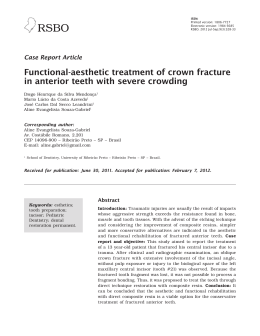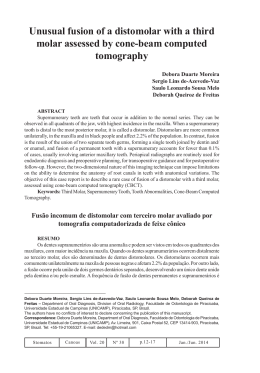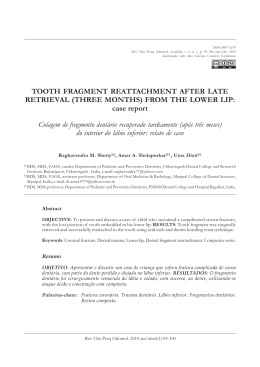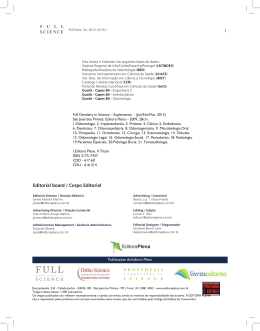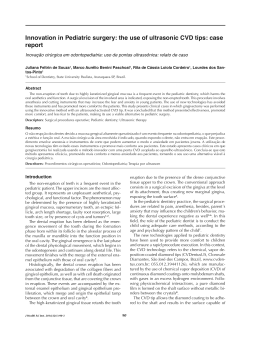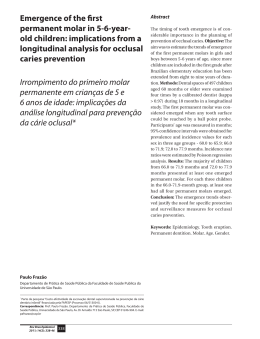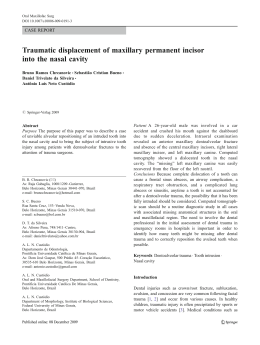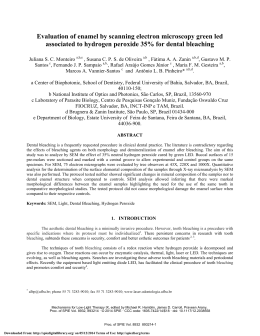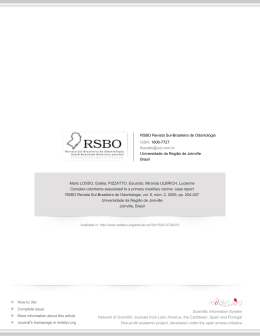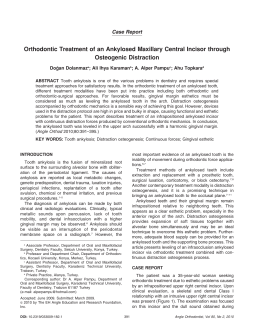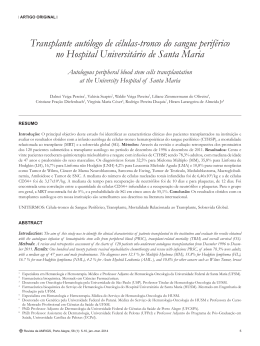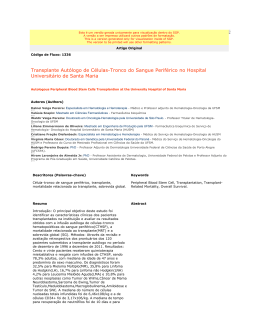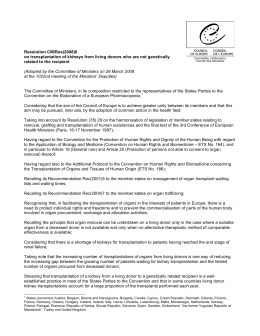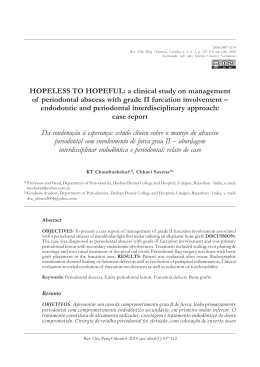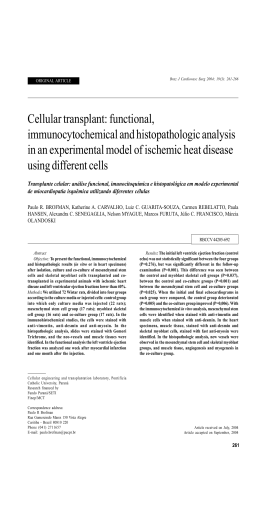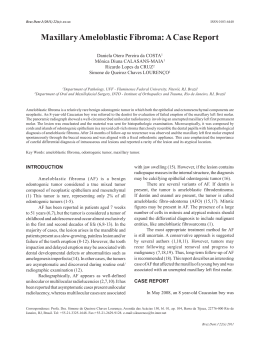ISSN: Printed version: 1806-7727 Electronic version: 1984-5685 RSBO. 2012 Jan-Mar;9(1):108-13 Case Report Article Dental autotransplant: case report Nathália Martins Pacini1 Dirceu Tavares Formiga Nery1 Daniel Rey de Carvalho1 Normeu Lima Junior1 Alexandre Franco Miranda1 Sérgio Bruzadelli Macedo2 Corresponding author: Alexandre Franco Miranda Universidade Católica de Brasília (UCB) – Curso de Odontologia Clínica Integrada – Campus I – QS 07 – Lote 01 – EPCT CEP 71966-700 – Águas Claras – Taguatinga – DF E-mail: [email protected] School of Dentistry, Department of Buccomaxillofacial Surgery and Integrated Clinics, Catholic University of Brasília – Taguatinga – DF – Brazil. 2 School of Dentistry, Department of Buccomaxillofacial Surgery, University of Brasília – Asa Norte – DF – Brazil. 1 Received for publication: March 11, 2011. Accepted for publication: May 12, 2011. Keywords: autologous transplantation; third molar; oral surgery. Abstract I nt r o duc t io n: T he autogenous t ra nspla nt at ion or dent a l autotransplantation is defined as the replacement of an absent or impaired tooth by another transplanted one, usually the third molar. The tooth is transplanted to a prepared or existing tooth socket occupied by the lost tooth, in a same person. This technique is considered a viable method due to its high success rate when properly indicated combined with a relatively low cost. Objective and case report: To report a clinical case study conducted in the Integrated Clinics of the Catholic University of Brasilia in a young melanoderm male patient, 13 years-old, who underwent late tooth transplantation technique, i.e., in two steps: the right upper third molar was transplanted to the socket of the right lower first molar. The case described showed incomplete root formation and radiographic following-up for eight consecutive months. Conclusion: This type of oral rehabilitation contributed to bone formation stimulation at the transplanted site, the maintenance of the masticatory function and the financial costs reduction for the patient, representing a further possible therapy in the dentist’s armamentarium. RSBO. 2012 Jan-Mar;9(1):108-13 – Introduction Tooth transplantation is the surgical transposition of a vital or endodontically treated tooth from its site at the oral cavity to another site, i.e., the tooth to be transplanted is submitted to an avulsion from its site of origin and transplanted to another natural or surgically prepared socket [4, 6]. This type of dental surgical intervention was firstly documented by Abulcassis, in 1050; however, only in 1564, the French dentist Ambroise Paré performed the first recorded surgery with details about tooth bud transplantation. In 1956, a transplantation technique for molars was described, and until today, the general guidelines of this surgical technique are practically the same. Notwithstanding, some techniques have been developed aiming to improve the prognosis, such as two-stage transplantation and prototyping [11, 12]. Tooth transplantation can be classified into autogenous (where the donator is the same person who will receive the tooth bud); homogenous (if the donation is performed by a person of the same specie of the receptor); and heterogeneous (if the donator is from a different specie of the receptor) [6, 13, 15, 18]. The transplantation is considered as an oral rehabilitation’s alternative approach, of conservative character, mainly in young patients presenting a tooth structure compromised by caries or in patients with little financial conditions to perform a high-cost treatment [10, 12]. Toot transplantation main indications are related to cases of congenital tooth absence; traumas; iatrogeny; atypical toot eruption; root resorption; extensive carious lesions; root fractures; periodontal disease; endodontic treatment failures (intentional reimplantation); indication for tooth extractions; and if the prosthetic treatment is unviable, due to socioeconomic reasons [2, 8, 17]. The main advantages of this procedure are to avoid alterations in the developing of the maxilla and mandible and be a conservative treatment with the possibility of alveolar bone development in the receptor area, as well as to constitute a viable method due to high success rate and relatively low cost compared to the traditional methods of rehabilitation, such as osseointegrated implants [13, 15]. Dental implants have been contraindicated in growing patients, and tooth transplantation is considered ideal in these patients because it contributes to bone growth and stimulation [14]. Because it is considered an effective alternative of oral rehabilitation, autotransplantation can be executed in a single appointment or in two stages, depending on each case [5, 8]. 109 The aim of this study was to report a clinical case of autogenous tooth transplantation in a teenager patient treated at the Integrated Clinic of the Catholic University of Brasilia, and followed-up for 8 postsurgical months. Case report A young melanoderm male patient, 13 years-old, was referred to the School of Dentistry Clinics of the Catholic University of Brasilia complaining about a discomfort and pus in the area of tooth #46. At clinical examination the lower right first molar presented its clinical crown destroyed by extensive carious lesion and pulp necrosis, which were radiographically confirmed; also, a periapical lesion with large bone rarefaction was seen in the radiograph (figure 1). Once was a minor pat ient, our protocol comprises the presence of the child’s family during the clinical examination as well as during the decision of all treatment planning and stages. Therefore, a free and clarified consent form was signed by the patient’s mother, where all treatment’s risks and complications were explained, authorizing the patient’s dental intervention and the possibility of autogenous toot transplantation. Treatment planning A mon g a l l s e vera l t re at me nt pl a n n i n g possibilities, we opted to perform autogenous tooth transplantation because the patient showed this intervention’s favorable characteristics: young patient, no contributory systemic disease, third molars with incomplete rhizogenesis (figure 1), as well as low financial condition as reported by his mother. Figure 1 – Initial panoramic radiograph showing periapical lesion with extensive rarefaction in tooth #46 and incomplete rhizogenesis in tooth #18 110 – Pacini et al. Dental autotransplant: case report Treatment A late tooth autotransplantation was executed, i.e., in two stages: first stage comprised the extraction of tooth #46 and tooth socket adaptation; second stage comprised the extraction of the tooth bud #18 and its repositioning in the tooth socket. Stage 1 – Extraction of tooth #46 Firstly, all pre-operative procedures were performed: i nt raora l a nt isepsis w it h 0.12% chlorhexidine digluconate, for one minute; perioral antisepsis with PVP; surgical paramentation according to biosecurity regulations. Patient underwent local anesthesia of inferior alveolar, lingual and buccal nerves with 2.5 tubes of 2% mepivacaine with 1:100000 epinephrine (DFL Indústria e Comércio Ltd.). After tooth extraction, the soft tissue at the socket bottom (compatible with chronic periapical lesion according to the radiographic image) was removed by curettage through Lucas curette and referred to histopathological evaluation in 10% formalin. Tooth extraction was copious irrigated with 0.9% saline and gingival tissue was coapted by interrupted sutures with silk thread (Ethicon 4.0 – Johnson & Johnson do Brasil Indústria e Comércio de Produtos para Saúde Ltd.). The patient was instructed to perform daily mouthrinsing with 0.12% chlorhexidine gluconate, twice a day (morning and night, 12h/12h, for seven days) and it was prescribed amoxicillin 500 mg orally (8h/8h for seven days), sodium dipyrone 500 mg/ml orally (35 drops 6h/6h for seven days). Stage 2 – Autogenous tooth transplantation – extraction of tooth #18 and implantation in tooth #46 socket The decision of employing tooth #18 as donator tooth was performed by the clinical assessment (measurement) of the tooth and of the space at the receptor area, i.e., the mesial-distal diameter of the donator tooth (#18) was compatible with the diameter of the receptor socket, contributing for the transplant’s favorable prognosis. This second stage was executed one week later than the first stage. All pre-operative procedures of the second stage were carried out as previously described. Patient was submitted to infiltrative anesthesia of the posterior superior alveolar nerve and local anesthesia of the major palatal nerve with three tubes of 2% mepivacaine with 1:100000 epinephrine (DFL Indústria e Comércio Ltd.). Toot h #46 socket was reopened a nd we performed a mild curettage of the connective tissue within it, in an attempt not to damage the tooth socket walls. An extensive osteotomy was performed for tooth #18 extraction, which made its extraction easy and contributed to minor traumas to its periodontal ligament. It is important to highlight that the receptor socket did not demand any adjustment. After tooth reimplantation, patient’s occlusion was checked, leaving the transplanted tooth in infraocclusion (figures 2 and 3). Figure 2 – Occlusal view just after tooth #18 transplantation Figure 3 – Periapical radiograph just after tooth #18 transplantation RSBO. 2012 Jan-Mar;9(1):108-13 – 111 Sutures were performed with silk thread (Ethicon 4.0 – Johnson & Johnson do Brasil Indústria e Comércio de Produtos para Saúde Ltd.) aiming to stabilize the tissues and the transplanted tooth. Non-rigid temporary splinting through malleable orthodontic wire and composite resin, from tooth #45 to tooth #47 was executed. The same post-operative recommendations and prescriptions of stage 1 were instructed to patient. Post-operative following-up The patient’s mother was instructed regarding to the importance of the following-up appointments. The patient was clinically and radiographically followed-up for eight months, comprising weekly appointments in the first month. At the second month, the non-rigid splinting was removed. Patient was then monthly followed-up (figures 4 and 5). Figure 4 – Eight-month following-up periapical radiograph. Note the partial rhizogenesis of the mesial root and bone neoformation Figure 5 – Final panoramic radiograph, eight months after autotransplantation 112 – Pacini et al. Dental autotransplant: case report Discussion The term transplantation has been generically used to represent the transposition of the biological tissues in its several forms [8]. According to Aguiar & Aguiar (2009) [1], tooth bud transplantation is a surgery aiming to replace the lost tooth by another sound one to be placed in the same site; it can also be related to intentional replantation, procedure in which tooth extraction, retrograde filling, and the tooth replantation is performed [2]. First molars are the teeth presenting the highest rate of tooth loss in young patients aging from 15 to 25 years-old due to extensive carious and/or endodontic lesions, mainly because they are the first permanent teeth to erupt into oral cavity as well as to exhibit a favorable morphology to plaque accumulation [10, 16], similarly to the case here described. For this reason, autogenous transplantations employ, in most times, the third molar because this tooth shows a late development compared to the other teeth, as highlighted by Giancristófaro et al. (2009)[6] and Bosco et al. (2000) [3]. The root formation stage of the tooth bud to be transplanted represents one of the main factors to transplantation prognosis. Teeth with open or close apex can be a “donator tooth”; however, an open apex tooth will remain vital and continue its root development after transplantation [4] while the teeth presenting complete rhizogenesis may or may not revascularize and will demand endodontic treatment [4, 9]. According to Reich (2008) [12] and Mejáre et al. (2004) [9], teeth having open apex and undergoing to transplantation presents greater probability success. The donator tooth should be in a favorable position to be extracted not to be damaged, have a mesial-distal diameter smaller or equal to the tooth to be replaced; the receptor site should not exhibit any periodontal lesions or acute infection, as well as to be enough large so that all the tooth structure to be transplanted has a free access, as highlighted by Pagliarin & Benato (2006) [10] and Clokie et al. (2001) [3]. The use of a rigid splinting promotes the complete immobilization of the tooth, stimulating tooth resorption. According to literature, non-rigid splinting seems not to negatively interfere in the periodontal ligament, because it allows a certain mobility, which is an important factor for periodontal fibers’ regeneration and favors the transplantation prognosis [7]. It is important to highlight that the time period that this splinting will be kept within oral cavity should be the least as possible not to occur an increase of post-autotransplantation root resorption, therefore, the splinting could be a favorable factor influencing the procedure success according to the studies of Valente (2003) [18], Baratto-Filho et al. (2004) [2] and Zambrano et al. (2002) [19]. In the case here reported, the patient showed a localized infection and periodontal lesion at the receptor site region; therefore, we followed-up the patient for eight months due to the failure probability, resulting in tooth functionality. The patient compliance in all autotransplantation stages is necessary for this procedure success, mainly to avoid complications during and after its clinical path; consequently, this procedure should be indicated for patients willing to follow all the recommendations [6, 9, 10, 12]. Conclusion It can be concluded that autogenous tooth transplantation, when well indicated, planned and performed, can be a viable alternative mainly in young patients with low socioeconomic conditions, allowing the reestablishment of the functionality (mastication) and aesthetics as well as to contribute clinically for bone formation stimulus at the transplanted site. Proper planning, surgical technique knowledge, the clinician’s ability to perform the procedure, and the patient’s compliance has a fundamental role in autotransplantation success. References 1. Aguiar E, Aguiar O. Transplante de germe dental. Diálogos e Ciência – Rev Rede Ensino FTC. 2009;3(9):107-14. 2. Baratto-Filho F, Vanni JR, Limongi O, Fariniuk LF, Travassos R, Albuquerque DS. Intentional ������������ replantation: case report of an alternative treatment for endodontic therapy failure. RSBO. ������ 2004;1(1):36-40. 3. Bosco AF, Neto MS, Nagata MJH, Pedrini D, Sundefelde MLMM. Evaluation ������������������������������ of the periodontal tissues of the mature teeth autotransplanted to either newly prepared or initial healing alveoli. Histologic study in monkeys. Rev Odontol UNESP. 2000;29(1-2):9-29. RSBO. 2012 Jan-Mar;9(1):108-13 – 113 4. Clokie C, Yau D, Chano L. Autogenous tooth transplantation: an alternative to dental implant placement? ���������������������������������� J Can Dent Assoc. 2001;67(2):92-6. 12. Reich P. Autogenous transplantation of maxillary and mandibular molars. ������������������ J Oral Maxillofac Surg. 2008;66:2314-7. 5. Cuffari L, Palumbo M. Cirurgia implante de germe dental. JBC. 1998 [cited 2008 Sep 1]. Available from: URL: http://www.cirurgiaoralcomartigos-transplantes-htm. 13. Sailer HF, Pajarola GF. Cirurgia bucal. Porto Alegre: Artmed; 2000. 6. Giancristófaro M, Júnior WP, Júnior NVR, Júnior HM, Silva CO. Transplante dental: revisão de literatura e relato de caso. Rev Odonto Univ Cidade de São Paulo. 2009;21(7):74-8. 14. Sato F, Lamashita H, Vidote R, Moraes M, Mazzonetto RO. O transplante dentário autógeno como alternativa à reabilitação nas perdas unitárias. Rev Bras Cirur Traumato Buco-MaxiloFacial. 2007;1(1):52-7. 7. Grandini AS, Barros VRM, Navarro NV. Avaliação clínica de alguns métodos de contenção empregados em reimplantes e transplantes dentais autógenos. Rev Odontol USP. 1989;3(4):469-501. 15. Sebben G, Dal MSC, Fernandes RCS. Transplante autógeno de terceiros molares inclusos. Rev Assoc Doc Pesq PUCRS. 2004;5:109-11. 8. Macedo JC, Medeiros PJ, Silva JS, Almeida RC. Autotransplante de germes de terceiros molares: relato de dois casos. ���������������� Rev Bras Odont. 2003;60:24-6. 16. Souza JG. Transplante autógeno de germe de terceiro molar. ������������������ Rev Gauch Odonto. 2002;50(3):175-6. 9. Mejáre B, Wannfors K, Jansson L. A prospective study on transplantation of third molars with complete root formation. ������������������������ Oral Surg Oral Med Oral Phatol Oral Radiol Endod. 2004;2(97):231-8. 17. Tatli U, Kurkçu M, Çam O, Buyukyilmaz T. Autotransplantation of impacted teeth: a report of the literature. Quintessence ��������������������������������� Int. 2009;40:589-95. 10. Pagliarin F, Benato M. Transplante dentário autógeno: apresentação de dois casos. Clín Pesq Odontol. 2006;2(3):231-40. 18. Valente C. Técnicas cirúrgicas bucais e maxilofaciais. 2. ed. Rio de Janeiro: Revinter; 2003. p. 237-40. 11. Pires MSM, Giorgis RS, Castro AGB, Beltrame J, Saueressing F. Transplante autógeno de germe de terceiro molar inferior com rizogênese completa para alvéolo de primeiro molar inferior. ��������� Rev Bras Cir Implant. 2002;34:157-63. 19. Zambrano CBB, Isolan TMP, Renon MC, Reach DF. Transplante autógeno-caso clínico: avaliação clínico-radiográfica. J Bras Clín Odonto Int. 2002;4(18):40-3.
Download
